mobile Ansicht, to the English Version tap the flag
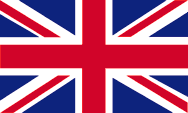

Bis zum Ausbruch Unabhängigkeitskrieges hatten die britischen Kolonien in Nordamerika keine eigentliche Flagge. Zeitweilig gab es eine Flagge für Neuengland, die sechs nordöstlichen Kolonien: Maine, Neu Hampshire, Vermont, Massachusetts, Rhode Insel und Connecticut. Diese zeigte ein Georgskreuz mit einem Baum in der Oberecke, später jedoch erscheint diese Flagge als Oberecke im Red und im Blue Ensign. Ab 1707 wurde der Union Jack in die Oberecke der Nationalflaggen der Kolonien des British Empire gesetzt, d.h. dass in den amerikanischen Kolonien als Flagge der britische Red Ensign geführt werden musste. Ob er amtlicherseits Badges getragen hat, ist unbekannt.
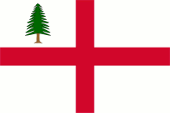
bis ca. 1680,
Neuengland (inoffiziell),
Quelle, nach: Corel Draw 4



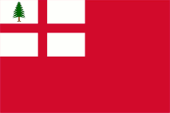
ab ca. 1680,
Neuengland (Handelsflagge),
Quelle, nach: Corel Draw 4



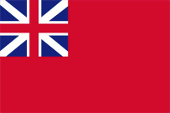
ab ca. 1707,
Neuengland (Handelsflagge),
Quelle, nach: Corel Draw 4




Eine erste rot-weiß gestreifte Freiheitsflagge wurde in Boston schon im Juli 1769, und wieder im Jahre 1773 anlässlich der "Boston Tea Party" benutzt. Die fünf roten Streifen auf letzterer repräsentierten möglicherweise die Kolonien Neuenglands. Im Oktober 1774 wurde in Taunton, Massachusetts ein Red Ensign mit dem Wahlspruch "Freiheit und Einheit" gehisst. Ein weiteres Zeichen des Widerstandes war die Aufstellung von "Freiheitsbäumen".
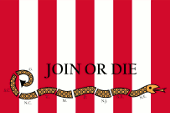
1769 & 1773,
Freiheitsflagge "Boston-Modell",
Quelle, nach: perenickushistc.weebly.com



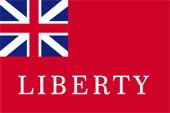
Oktober 1774,
Freiheitsflagge "Taunton-Modell",
Quelle, nach: Die Welt der Flaggen



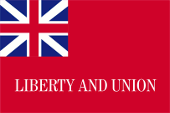
Oktober 1774,
Freiheitsflagge "Taunton-Modell",
Quelle, nach: blog.usaflagco.com






Das Kiefernemblem entstand in Neuengland zu einem sehr frühen Zeitpunkt und dürfte später mit dem Freiheitsbaum gleichgesetzt worden sein. Ein weiteres beliebtes Emblem jener Zeit war die Klapperschlange mit dem zugehörigen Wahlspruch "Tritt nicht auf mich". Die Schlange war ein typisch amerikanisches Symbol und wurde später mit dreizehn Gliedern dargestellt. Bei den ersten Kampfhandlungen bei Lexington und Concord gab es keine spezielle Flagge auf amerikanischer Seite, wenn auch die "Bedford-Flagge", die eine alte Kavalleriestandarte aus dem englischen Bürgerkrieg gewesen sein dürfte, bei dieser Gelegenheit gezeigt wurde. Die Benutzung des Red Ensign mit einem Wahlspruch im fliegenden Ende, des alten Red Ensign mit der Kieferflagge in der Oberecke oder einer einfachen Kieferflagge scheinen einige der Möglichkeiten der Amerikaner gewesen zu sein. Ebenfalls in Betracht gezogen wurde eine Klapperschlangenflagge, wie sie Colonel Gadsden (South Carolina) vorschlug. Diese war gelb mit der Klapperschlange und dem Wahlspruch. Ein 1775 in Pennsylvania gebildetes Regiment benutzte einen Red Ensign mit einem Klapperschlangenbadge im fliegenden Ende (Proctor's Independent Battalion, Westmoreland County). Eine Streifenflagge mit Klapperschlange wurde von der Marine South Carolinas benutzt. Die von Washington in die Massachusetts Bay geschickten Schiffe führten die Kieferflagge vom September 1775. Diese Flagge trug den Wahlspruch "Appeal to Heaven".
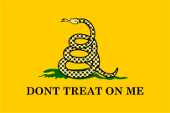
1775,
Klapperschlangenflagge "Gadsen-Modell",
Quelle, nach: portlandflag.org





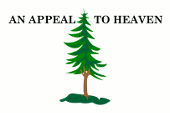
1775,
Kiefernflagge "Massachusetts-Modell",
Quelle, nach: etc.usf.edu



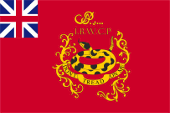
1775,
Freiheitsflagge "Westmoreland-Modell",
Quelle, nach: triblive.com




Als am 03.07.1775 General George Washington zum Oberbefehlshaber der Armee britischer Kolonien in Amerika wurde, war es notwendig, nicht nur die militärischen Kolonialeinheiten zu einer einheitlichen Armee umzuformen, sondern auch eine gemeinsame Flagge anzunehmen. So wurde ein Flaggentuch mit dreizehn waagerechten Streifen – roten und weißen – nach der Anzahl der Kolonien und mit britischer Flagge im Kanton, geschaffen. Sie wird heute "Grand Union"-Flagge oder "Continental Colors" genannt. Das Vorhandensein des britischen Union Jacks brachte vermutlich zum Ausdruck, dass die Anführer dem britischen König gegenüber loyal bleiben wollten. Möglicherweise wurde sie schon am 03.12.1775 in Philadelphia auf amerikanischen Schiffen benutzt, doch spricht erheblich mehr dafür, dass sie erstmals am Prospect Hill in Cambridge, Massachusetts gehisst wurde, wo die Gontinental Army am 01.01.1776 lagerte. Sie wurde die allgemeine Flagge der Kolonien, neben der Klapperschlangenflagge, mit der sie manchmal kombiniert wurde. Nach erfolgreichem Kampf der Kolonialarmee gegen das britische Heer wehte die Flagge anlässlich der Unabhängigkeitserklärung am 04.07.1776.
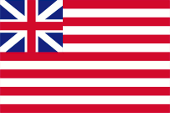
1776–1777,
Grand Union Flag,
Quelle, nach: Corel Draw 4





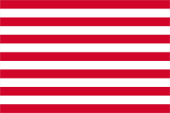
1775–1800,
parallel gültige Variante,
Quelle, nach: Corel Draw 4




Die Grand Union Flag wurde bis zum 14.07.1777 benutzt, als vom Kongress beschlossen wurde, dass im Kanton Sterne erscheinen sollen, deren Anzahl sowie die Anzahl der Streifen mit denen der Konföderationsmitglieder übereinstimmen. So wurde die britische Flagge aus der Oberecke entfernt, und durch ein blaues Feld ersetzt, das mit dreizehn weißen Sternen belegt war. Einer Legende nach, soll die erste Flagge Betsy Ross im Auftrag Georg Washingtons angefertigt haben. Wie die Flagge genau aussah, ist allerdings nicht bekannt, da sie nicht erhalten blieb. Aus dem Text des Gesetzes ergab sich auch nicht, wie die Sterne angeordnet werden sollen, da hier lediglich über "neue Konstellation" gesprochen wurde. Die dreizehn weißen fünfzackigen Sterne dürften so im Kreis oder auch in mehreren Reihen angeordnet gewesen sein. In der ersten bekannten Darstellung aus dem Jahre 1778 oder 1779 liegen die Sterne in Reihe. Man weiß heute auch nicht, warum der Union Jack überhaupt durch eine "neue Konstellation" ersetzt wurde. Diese wirkungsvolle Kombination von Sternen und Streifen fand jedenfalls in der ganzen Welt Nachahmung. Vor der Schaffung des Sternenbanners hatte praktisch keine Flagge Sterne. Seitdem finden sie sich auf Tausenden von Flaggen.
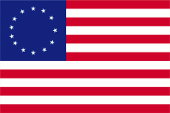
1777–1795,
erste "Stars and Stripes", mögliche Variante,
Quelle, nach: Corel Draw 4



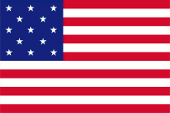
1777–1795,
erste "Stars and Stripes", mögliche Variante,
Quelle, nach: Corel Draw 4




Zu dem Zeitpunkt, als Vermont und Kentucky zu Mitgliedern der Konföderation wurden (1791/1792), erhöhte sich die Zahl der Sterne und Streifen seit dem 01.05.1795 auf fünfzehn. In den folgenden Jahren wurde vom Kongress keine Änderung der Flagge angenommen, obwohl die Mitgliederzahl stets zunahm. Die Herstellung von neuen Flaggen war nämlich zu teuer. Darüber hinaus drohte auch die Gefahr, dass bei einer hohen Zahl von waagerechten Streifen, vor allem auf offenem Meer, die Flagge an guter Kenntlichkeit verlieren könnte. 1818 wurde daher vom Kongress der Grundsatz angenommen, dass die Streifenzahl wieder zu ursprünglich dreizehn zurückkehrt. Die Sternenzahl kann dagegen erhöht werden, jedoch immer zum 04.07., dem Tag der Unabhängigkeit. Am 04.07.1818 wurde also bereits die dritte offizielle amerikanische Flagge mit zwanzig Sternen im Kanton angenommen.
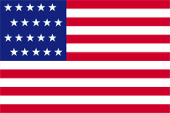
1818,
Nationalflagge der USA,
Quelle, nach: Corel Draw 4




Diese Praxis wurde seither beibehalten, und die gegenwärtige Flagge stellt schon die 28. in Folge dar. Bestimmungen für die Gestaltung der Flagge wurden 1912 erlassen, für die Farben 1934. Die genaue Anordnung der Sterne wird jedesmal neu festgelegt, wenn neue Sterne hinzukommen, die in neuerer Zeit immer in einer Reihe lagen. In der heutigen blauen Oberecke gibt es so fünfzig Sterne, die in neun Reihen angeordnet sind. In fünf von ihnen gibt es dann je sechs und in vier Reihen je fünf Sterne. Jeder Unionstaat hat eine Flagge, ein Siegel und ein Staatsemblem, zum Beispiel einen Vogel, einen Baum oder eine Blume. Die Flaggen sind unterschiedlicher Herkunft und zu unterschiedlichen Zeiten entstanden.
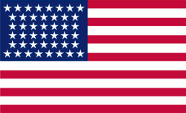
1891–1896,
Nationalflagge der USA,
Quelle, nach: Corel Draw 4




1912–1959,
Nationalflagge der USA,
Quelle, nach: Corel Draw 4




Andere historisch wichtige Flaggen:
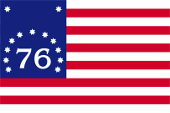
1812, 1826, 1876, (?),
"Bennington Flag" / "Fillmore Flag",
Gedenkflagge der Schlacht von Bennington 1776,
Quelle, nach: Corel Draw 4,
Wikipedia (EN)





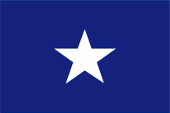
"Bonnie Blue Flag",
1810 – Republik Westflorida – West Florida Republic,
Quelle, nach: Corel Draw 4






Quelle:
Die Welt der Flaggen,
Flaggen Wappen Hymnen,
Volker Preuß

![]()

























